- Which festivals are in month of Kartik & what is their significance (includes each day of Diwali). Why are Diyas lit. What are Six Virtues of wealth. Why is Lakshmi Puja done. What is tithi time for each puja
Kartik is the month of
victory of good over evil, the victory of Devi Lakshmi over darkness, of
Kartikey over Tarakasur, Shri Ram over Ravan, and Shri Krishna over Bhaumasur.
The arrival of Hemant Ritu, the pleasant pre-winter season when the leaves turn gold for new leaves to take their place, a nip in the air and the scent of marigolds bring indications of the most awaited festival, Diwali. Beginning from Sharad Poornima (October 28, 2023) till the Kartik Poornima (November 12, 2023) the entire month is festive. Kartik month is considered the month of Shri Vishnu. The astronomical conditions are conducive for good health, wealth, and overall prosperity in this month. Kartik also is the month of victory because, Shivputra Kartikey’s victory over Tarakasur, Shri Ram’s victory over Ravan, Shri Krishna’s victory over Varah putra Bhaumasur and Devi Lakshmi’s victory over darkness.
On Kartik Poornima, using the north-eastern monsoon
winds that blow from mid-November, the ancient Hindu mariners sailed to Sri
Lanka, down the Straits of Malacca towards Palembang to Sumatra, Bali,
Yavadwip, Borneo and Vietnam. The Malays, Indonesians, Bornean, Viet, Burmese,
Sri Lankans, Cambodians, also Thai and Laotian till date, worship and light
lamps on Kartik Poornima.
Hindu festivals, traditions
and rituals have attached benefits on human mind and body because of their
occurrences on particular Ritus/ seasons and astronomical conditions.
The Magnitude of the Earth’s revolution around the Sun brings about six Ritus/ seasons which not only change temperature, affecting soil moisture, evaporation, river flows, lake levels, snow cover, vegetation etc, they also affect the internal environment of human beings. All Hindu festivals, ritualistic traditions, fasting, specific diets and regimes are thus based on environmental and biological changes to regulate our homeostasis equilibrium and to promote physical and mental health, backed by wisdom.
Hindu
civilisation gave the world the concepts of Ritucharya, meaning ayurvedic
seasonal lifestyle.
Nevertheless, come Diwali the anti Hindu liberal elite start their pollution and cracker ban rants, some bollywood celebrities have gone as far as wishing an unhappy diwali to those who burn crackers, the brands display their pseudo secular attitude by running vicious advertisement campaigns against Hindu festivals. Judiciary also jumps in calling it the festival of pollution, the fire-works industry too has been repeatedly targeted. Children are brainwashed by schools calling Diwali a cultural and not a Hindu Dharmik festival. “Diwali history is a contested one, torn between myth and appropriation” said a 2021 article in The Print. Why are such views expressed
only for Hindu festivals? To debunk and change this narrative the Hindus must
know the ancient wisdom attached to all their festivals & rituals.
Hindu traditions are an easy target. On pollution
we look at the effect more than the cause.
Also read IIT-Kanpur study says trucks and road dust are bigger contributors to Delhi’s pollution than cars N To mitigate air pollution in
Delhi look beyond tokenism N Mining in Aravalis has increased
Delhi pollution N Red Signals from Meat N Why producing
Beef is bad for the environment
Decolonise your mind!
Festivals in Kartik Month
1. Karwa Chauth- (Nov 1, 2023) Chaturthi, the fourth day of Kartik
when the slain head of Ganesh ji landed on the moon and Shivji brought His son
back to life, is celebrated as Karwa Chauth. The moon on this day is thus seen
as Shiv with son Ganesha.
Since the Moon symbolizes the subconscious and
conscious mind, Hindu women observe a fast and worship the Moon God Chandra Dev
for stability in married life. At moon rise, only after offering Argya/ water
from Karwa, an earthen pot, do they drink water and consume food.
Read Significance of Karwa Chauth
2. Ahoi Ashtami- (Nov 5, 2023) To ward off the darkness caused due to the Sun’s transit, the Vedic Rishis started the tradition of Akaash Deep daan- lighting up Mandirs, river banks and neighbourhood with oil lamps starting from Ahoi Ashtami, the eighth day of Kartik.
3. Rama Ekadasi
कृष्णपक्षे विशेषेण पुत्र पंचदिनानि च।
पुण्यानि तेषु यो दत्ते दीपं सोऽक्षयमाप्नुयात्।
Translated as, lighting lamps from Krishna Paksh Rama Ekadashi till Deepawali on Amavasya is very auspicious, it brings positivity and peace.
Rama
Ekadashi begins on November 8, 2023, at 08:23 am and ends on November 9, at
10:41 am. Ekadashi fast will be observed on November 9, and Paran time will be
from 05:52 am to 08:07 am on the November 10th.
On Dwadashi of Kartik in the Krita/ Sata Yuga, the
Divine Cow Kamadhenu had incarnated from Samudra Manthan.
On Trayodashi Bhagwan Dhanwantri incarnated, on
Chaturdashi Maa Kali and on Amavasya of Kartik, Mata Lakshmi had incarnated
from the Samudra Manthan. Hence on their Avtaran tithis, Govatsa Dwadashi, Dhanwantari Triyodashi, Narak Chaturdashi and Deepawali are celebrated on
the 12th, 13th, 14th and 15th days of this month.
4. Govatsa Dwadashi/ Nandini Vrat- (November 9, 2023, 10:41 am 12:35 pm) Hindus worship
cows, the Holy beings that have befriended human beings since aadi Kaal and pay gratitude to them for
their contribution in the sustenance of human life.
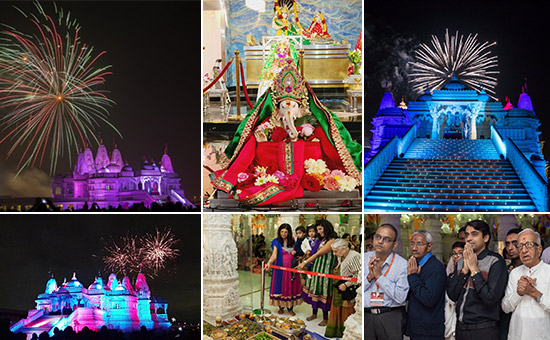 Deepavali in Canada.
Deepavali in Canada.
5. Dhan Trayodashi - (November 10, 2023, Pooja mahoorat is from 5.47 pm
to 7.43 pm, Tithi begins 12:35 pm and ends at 01:57 pm on Nov 11).
Shri Vishnu Bhagwan had incarnated from Samudra
Mantahan as Dhanwantri, the Devta of Ayurveda carrying an Amrit Kalash on this
day. Dev Guru Brihaspati asked the Devtas to worship Kuber ji, the Devta of all
treasures and Mata Lakshmi on this day for prosperity. Hence, along with
Bhagwan Dhanwantri, Mata Lakshmi and Kuber ji are worshipped on Dhanteras.
Deep Daan is done on this day for Yama, the Devta of death, a
deepak with four wicks is lit on the main door outside the house for Yama, to
protect members of the family from unforeseen mishaps from all four directions
and untimely death.
6. Narak Chaturdashi - (Nov 12, 2023) (tithi starts on Nov 11, 01.57 pm
till 02.44 pm on 12th November).
On the 14th day of the Krishna Paksha of Kartik month, Shri Krishna slew Varaha’s son Bhaumasur also called Narkasur and smeared his blood on His forehead as a mark of victory. Before dying, Bhaumasur wished this day to be celebrated as Narak Chaturdashi. Shri Krishna’s Holy bath after this is called Abhyanga Snan. Hindus
have been observing the ritualistic Holy bath on this day since then. They
follow the tradition of with herbal scrubs and oil-bath early in the morning on
Narak Chaturdashi.
People of Dwarka lit lamps to welcome the victorious
Krishna, who returned with 1600 Arya women captured by Bhaumasur.
This day is celebrated as Kali Chaudas also since Maa Kali had incarnated on the same tithi, the
Krishna Paksh Chaturdashi of Kartik month.
On this tithi, Bhagwan Vishnu had promised to visit
Raja Bali every year.
Hanuman ji was also born on same tithi. Hence in
Ayodhya at Hanumangarhi, His jayanti is celebrated on this day. Some consider
Hanuman Jayanti to be on Chaitra Poornima though.
7. Deepawali/ Lakshmi Pooja- (Amavasya Tithi begins - 02:44 pm on Nov 12 and ends at 02:56 pm
on Nov 13, 2023)
Devi Lakshmi bestows wealth, good luck, success and
grace, hence Lakshmi pooja is a major tradition during Deepawali. Wealth as per
Hindu Dharma, has six virtues namely, Saam
meaning a calm mind, Daam is awareness of one’s thoughts and deeds, Uparati
is being unaffected by external objects and circumstances, Titiksha means remaining neutral- no likes or dislikes, Shraddha is devotion, and Samadhan is
focus on your goal.
To be rid of fear from death and poverty, from
Dhanteras to Amavasya, Raja Bali for three days lit lamps for Yama and
worshipped Lakshmi ji.
This day is also celebrated as Kedar Gowri Vrat
because on this tithi, Shiva became Ardhanarishwara,
one with Devi Parvati.
Devi Saraswati is also worshipped on this Tithi and
her Pooja is called Sharda Pooja. New account books are worshipped as Chopad Pooja on this day.
In Jain Darsana, Diwali is when the 24th Tirthankara
Bhagwan Mahvir attained moksha at Pawapuri, Bihar.
Read Mantras to worship Goddess Lakshmi
Auspicious Choghadiya Muhurat for Diwali Lakshmi Pooja:
Shubh- 02:44 pm to 02:47 pm.
Evening, Shubh, Amrita, Char- 05:29 pm to 10:26
pm.
Night, Labh- 01:44 am to 03:24 am, on Nov 13.
Early Morning, Shubh- 05:03 am to 06:42 am, Nov 13
Significance of lighting Ghee Deepak.
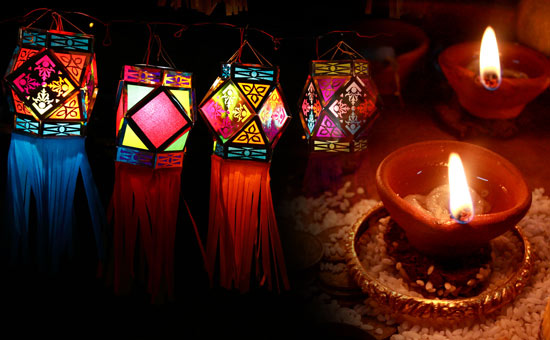
Being nearest to the Aakash Tatva, the energy provider Agni is invoked in a deepak to become one with the celestial dimension/Cosmic energy and to energise one’s magnetic field.
When Maa Lakshmi incarnated in Sata Yuga, Devtas lit
hundreds of Diyas/ lamps in Her honour.
In Treta Yug, on the victorious return of Shri Ram,
the people of Ayodhya lit Deepaks.
In Dwapar Yuga, Deepaks were lit for Shri Krishna’s victory over Bhaumasur.
8. Govardhan Pooja- (Pratipada Tithi begins at 02:56 pm on Nov 13, 2023,
and ends at 02:36 pm on Nov 14).
On the Shukla Paksha Pratipada of Kartik, Krishna
saved the Brajwasis from the flooding rain by securing them under the Govardhan
Parvat. He did this for seven days and enlightened them about the importance of
cow/ live-stock and environment.
Worshipping cows and nature, cooking 56 Bhog/Annakut for Shri Krishna continues
as a tradition for Hindus.
This day is also observed as Bali
Pratipada Pooja, Raja Bali visits Bhulok/ Earth for three days and
blesses His devotees on this Tithi.
Read Bali Yatra in Odisha
Hindus of Odisha launch toy boats with oil lamps near
river banks and ponds, as a symbolic gesture of the Sea voyage of their
ancestors who travelled for four months taking advantage of the favourable
winds. Bali Jatra/ yatra that begins on Kartik Poornima, it bears testimony to
the rich maritime legacy of ancient Utkala Desh when Hindus took with them
Bhartiya goods, Sanatan values and culture across the world.
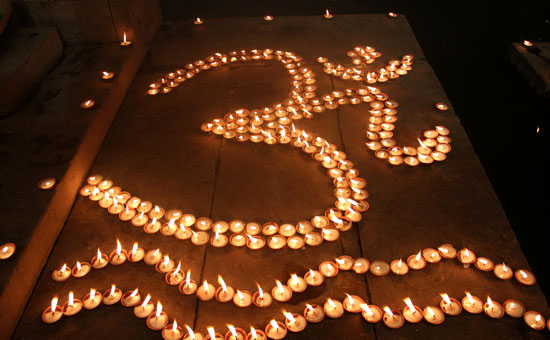
People of Tai cultures, Thailand, Laos, Shan, Mon,
Tanintharyai, Kelantan, Kedah, Xishuangbanna, Myanmar, Cambodia, Sri Lanka
etc., light lamps near/ in water bodies and celebrate Kartik Poornima, Dev
Deepawali in their own ways to this day.
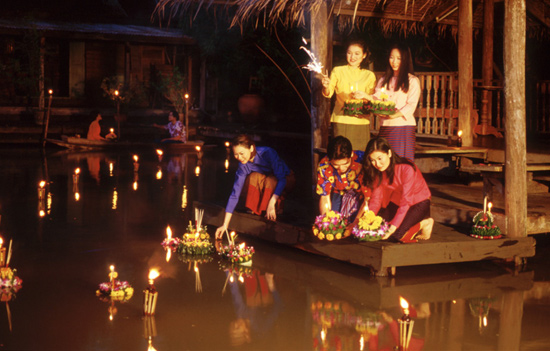 Kartik Poornima is celebrated as Festival of Lights in Thailand or Koy Krathong
Kartik Poornima is celebrated as Festival of Lights in Thailand or Koy Krathong 9. Bhai Dooj-
(Dwitiya Tithi begins on Nov 14, at 02:36 pm, and ends at 01:47 pm on Nov 15,
2023, Bhai Dooj Aparahn time is 01:10 pm to 03:19 pm on 14th)
Surya putra Yama Dev visited his sister Yamuna/ Yami on the Shukla Paksha Dwitiya of Kartik month also called Bhratri Dwitiya, Yama Dvitiya or Bhai Dooj. Pleased with Yamuna’s love and devotion, Yama professed that the brothers who visit their sisters on this day to check on their well-being will be protected from all evil and be blessed with a long life. Traditionally, siblings take a holy bath in river Yamuna on this day.
Subhadra too had welcomed and worshipped her brother
Shri Krishna when he visited her on this Tithi while returning from his victory
over Bhaumasur.
This Tithi is also celebrated as Chitragupta Jayanti because on this day was born the
seventeenth Manas putra of Brahma ji, Bhagwan Chitragupta. Shri Chitragupta
keeps all accounts of the deeds of living beings. From Kartik Amavasya till
Dwitiya, the dependents of Chitragupta keep their pen/ writing work aside, and
only after worshipping Chitragupta and the pen do they resume writing. All
Poojas done for Victory, strength and wisdom are said to be incomplete without
worshipping Chitragupta. Bheeshm Pitamah too had worshipped him while he lay on
the bed of arrows.
10. Chhath Pooja-
(Nov 17 to Nov 20, 2023)

The Rigvedic people are believed to have lived on solar energy for four days from the 4th day to the 7th day of the Shukla Paksha of Kartik.
Chhat pooja is a tradition that has continued since then.
Devotees fast all four days and worship Surya Devta, the prime source of energy
that sustains life on Earth. Usha the first ray of the Sun and Pratyusha, the
last ray of the setting Sun is worshipped during Chhath.
Prabodhini Ekadashi/ Devotthan Ekadashi - (Ekadashi
Tithi begins at 11:03 pm on Nov 22, 2023, and ends at 09:01 pm on Nov 23.)
The 11th day of Shukla Paksh of the Kartik month is
Prabodhini Ekadashi/ Devotthan Ekadashi when Vishnu ji wakes up from His
Chaturmas sleep in Kshirasagar, the four months when no auspicious tasks take
place.
Read Significance
of Chhat Pooja
11. Tulsi Vivah (Dwadashi Tithi begins at 09:01 pm on Nov 23, 2023 and ends at 07:06 pm on Nov 24, 2023.)
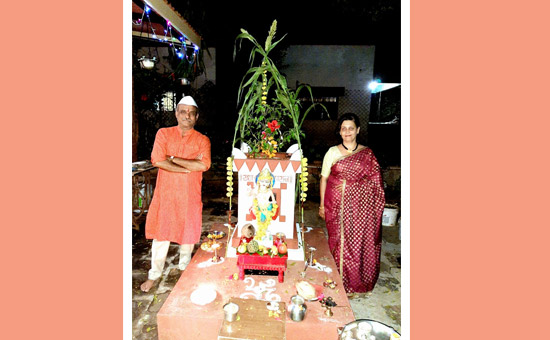
Tulsi being Vishnu Priya, is wedded to Shaligram on this day to invoke Shri Hari Vishnu and seek His blessings.
Read About
Tulsi Vivaha
12. Dev Deepawali - (Purnima Tithi begins at 03:53 pm on Nov 26, 2023 and ends at 02:45 pm on Nov 27, 2023, Pooja Mahoorat is from 05:08 pm to 07:47 pm.)
On Kartik Poornima, Brahma ji incarnated from Brahma
Sarovar, Pushkar. See album of Kartik Purnima at Pushkar
It is also called Tripurari Poornima because on this tithi Tripurari Shiv performed Tandav and burnt the settlements of Tarakasur’s three sons Tarakah, Kamalaksh and Vidyutmali, and then descends to bathe in the Holy Ganga. On Kartik Poornima is also Guru Nanak Jayanti.
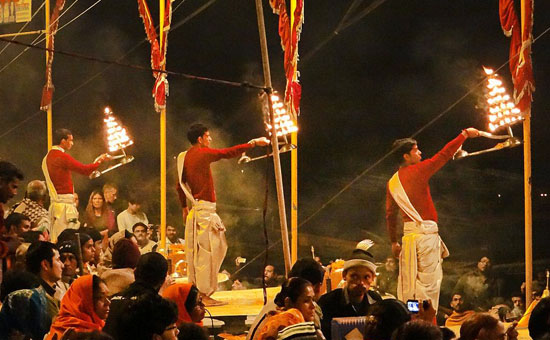 Ganga Aarti, Dev Deepavali. 2013.
Ganga Aarti, Dev Deepavali. 2013.
13. Guru Nanak Jayanti is on November 27 that also happens to be Kartik Purnima.

Read Guru Nanak's essential teachings
Since Diwali time is early winter when cold winds
start blowing, the rituals and foods are recommended in Ayurvedic Ritucharya to
suit the changing weather. The consumption of sweets, sugarcane, new rice,
dairy products, sesame, ghee, etc., for high energy levels, Vyayam (exercise), Abhyanga (oil massage) and lepas, Atapa sevana/ sunbath were
thoughtfully prescribed.
There is no questioning of the wisdom of our Rishis.
Do not let the fabricated narrative around Deepawali kill the divinity, charm
and grandeur that our ancestors have passed down to us generation after
generation.
Deepawali illuminates Bharat from Earth to the Skies.
This Deepawali, Hindus must light up every Mandir with Deepaks because as per
Shastra, once Pratishthit the Deity
never leaves the Mandir even if the Pratima or the Mandir structure is
damaged.
Hindus have had a long history of Tapasvis, kings and commoners engaging in reconstruction of
Mandirs, let us pledge this Deepawali to reclaim what is rightfully ours, our
Mandirs.
Shubh Deepawali. May there be more light in your life.
Also read
1. Deepavali – a cocktail of fun, frolic and philosophy
2. Why do Hindus
worship animals
3. Diwali in New Jersey, USA